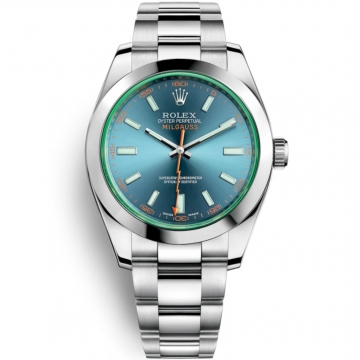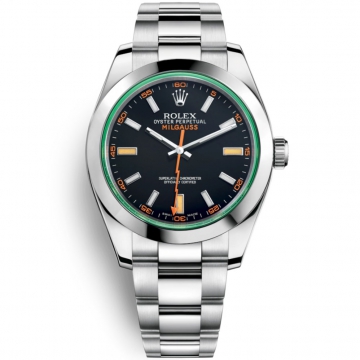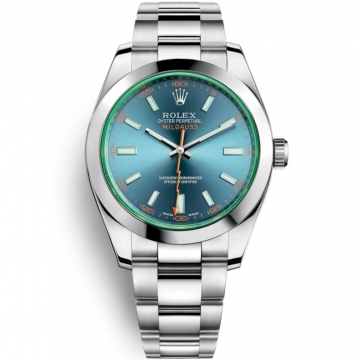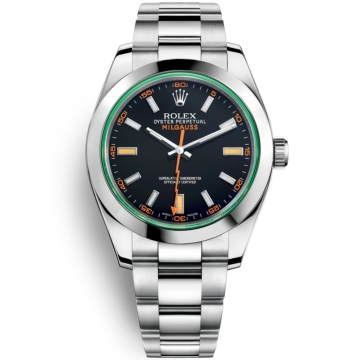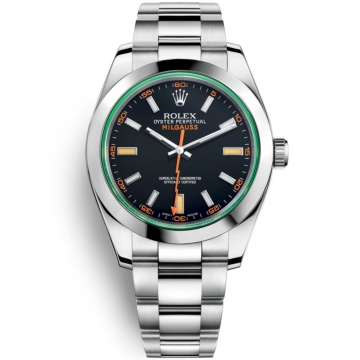Rolex Milgauss
Milgauss is an interesting watch in the Rolex collection. The model, first released in the 1950s for scientists and engineers, gets its name from the words "mille" and "Gauss" (the latter being the unit of magnetic field), which literally translates to 1000 Gauss.
The middle of the 20th century is an era of unprecedented flowering of science. Nuclear physics, cybernetics, astronautics ... In these areas, powerful instruments and equipment were used that created strong electromagnetic fields. When exposed to such fields, the watch magnetizes metal elements. For example, when magnetizing the hairs of a spiral, they can stick together and the clock either starts to rush very much (several minutes a day), or even stops altogether. In those years, there were no special devices for demagnetizing in watch workshops, and the best minds of that time were faced with the inability to use their Patekas and Vacherons, working for the good of mankind in their laboratories.
It was in this context that various manufacturers began to study how to create watches that could withstand magnetic fields. IWC was the first to launch a widely available watch that is resistant to these fields, ahead of the competition. The model was aptly named Ing? Nieur (Engineer), reflecting the progressive nature of this watch. Not to be outdone, during the same period, Rolex also launched its own magnetically resistant watch - the Rolex Milgauss.
The main innovation in both the Rolex Milgauss and the IWC Ing? Nieur and other similar watches is the use of a Faraday cage that covers the movement. Just as staying inside an airplane protects you from the effects of lightning, a Faraday cage (a ferromagnetic shell around a mechanism) will deflect current or a magnetic field and protect the entire mechanism, including the balance wheel and its spiral. Anti-magnetic protection is an important innovation in watchmaking, providing a new level of watch protection along with shockproof devices, dust protection, water resistance and other engineering solutions that ensure the performance of watch movements in a variety of conditions.
Designed and manufactured by Rolex, the watch has been tested against magnetic fields up to 1000 gauss a few kilometers from the Rolex factory at the European Organization for Nuclear Research (CERN). Nuclear physicists were in many ways the target audience for the Milgauss, and the scientists actually tested the watch for themselves. Having undergone severe repeated tests in the strongest magnetic fields, where other watches did not have the slightest chance to "survive", Rolex demonstrated complete indifference to all attempts to disable them and at the end of the tests continued to walk with chronometric accuracy.
The Milgauss 6541 was introduced in 1956 and was one of the first mass-produced wristwatches to accurately track time in strong magnetic fields thanks to its soft iron inner case. In fact, this was the second Milgauss after Ref. 6543 (despite the higher number, reference 6543 was actually the first). The Rolex 6543 was produced in very small numbers and bears little resemblance to subsequent models.
The design of the Milgauss 6541 was originally very similar to another Rolex professional model known for its resistance not to magnetism, but to water - the Submariner. Like the Submariner, the Milgauss was presented in an Oyster steel case and had a black rotating bezel with contrasting symbols and a dial with luminescent indexes that stylistically made it look like a sports watch. The striking red Milgauss lettering on the field of the dial is an important feature of the watch for collectors, which additionally distinguishes this model in the Rolex line.
During the XX century, the Milgauss underwent only one major update - in the 1960s, when Rolex introduced the 1019. The new watch absorbed quite a few changes, the most obvious of which were a sleek steel bezel, new hour markers and new hands. Moreover, the corporate design of the second hand in the form of a lightning has been replaced by a classic straight line with a red triangle at the end, in harmony with the red inscription “Milgauss” on the dial. And although two versions of the dial were made - black and silver, something was wrong in them, the watch turned out to be boring and impersonal, lost its zest and interest in them gradually began to fade.
Scientists and researchers, for whom Milgauss was largely designed, began to actively switch to fashionable and technologically advanced quartz and electronic watches, which were also more accurate and cheaper than mechanical chronometers. The Milgauss never found an audience, and Rolex eventually ditched the watch in 1988, ending production entirely. Now at auctions Milgauss Ref. 1019 costs about $ 30,000 and Ref. 6541 and 6543 in good condition sell for $ 200,000 to $ 300,000.
At a new peak of interest in mechanical watches in 2007, the Milgauss was again presented in the Rolex range (Ref. 116400). For 20 years of complete obscurity, this model was practically forgotten and its appearance caused an ambiguous reaction in the market. Rolex's reference to historical continuity and protection from magnetic fields did not impress potential buyers. What are electro-magnetic radiation? Who needs all this, the captain of a nuclear submarine? It would be better to add a date function ... Buyers were perplexed and at first bypassed this model.
The remake failed, but Rolex did not give up this time and used several interesting color schemes, which generally corrected the situation, and Milgauss took its rightful place in the line of popular Rolex models. First, a green sapphire crystal was launched. This was a very unusual decision for the conservative Rolex. Rolex calls this glass Glace Verte or Green Glass. No other models of this brand, and almost all other watch manufacturers, can boast of colored glass. In addition, the glass was scratch resistant, like any sapphire, and was resistant to fading. Neither ultraviolet light nor exposure to household chemicals led to color change. The color of the glass was only visible when viewed from the side and created an unusual green halo around thedial.
At first, there were persistent rumors that this decision was temporary, since this model is a jubilee and soon the green glass will cease to be produced.
This greatly fueled the demand for these watches among collectors, they were swept away in all boutiques and the price of green milgauss on the secondary market became 2 times higher than the store price. This rumor was fueled by the Rolex company itself, which stated that Green Glass is so difficult to manufacture that the engineers did not even begin to make a special patent for it, since it is allegedly impossible for practically any manufacturer to mass-produce such glass. The rumor, by the way, turned out to be false and soon the price returned to an acceptable level.
The next color break for Milgauss was the appearance in 2014 of the bright blue Z-Blue dial, which was combined with green glass. A very effective play of color was created from different angles and the number of fans of this model increased significantly.
By 2020, Rolex discontinued the Milgauss with a white dial, and conventional glasses were also discontinued. Only the black and blue dials remained, which were combined with the green glass. And apparently, this is not the final stage in the evolution of this long-suffering model.
A big plus of the milgauss design is its versatility. It looks cool both on the beach and at a business meeting. And it always has a spectacular zest in the form of green glass that attracts attention. It is housed in a robust, elegant 40mm Oyster case and is equipped with a twin-lock crown that provides 100 meters of water resistance. Basically, if you want to have only one watch for all occasions and at the same time not boring design, then milgauss is a great unversal option.
Milgauss is an interesting watch in the Rolex collection. The model, first released in the 1950s for scientists and engineers, gets its name from the words "mille" and "Gauss" (the latter being the unit of magnetic field), which literally translates to 1000 Gauss.
The middle of the 20th century is an era of unprecedented flowering of science. Nuclear physics, cybernetics, astronautics ... In these areas, powerful instruments and equipment were used that created strong electromagnetic fields. When exposed to such fields, the watch magnetizes metal elements. For example, when magnetizing the hairs of a spiral, they can stick together and the clock either starts to rush very much (several minutes a day), or even stops altogether. In those years, there were no special devices for demagnetizing in watch workshops, and the best minds of that time were faced with the inability to use their Patekas and Vacherons, working for the good of mankind in their laboratories.
It was in this context that various manufacturers began to study how to create watches that could withstand magnetic fields. IWC was the first to launch a widely available watch that is resistant to these fields, ahead of the competition. The model was aptly named Ing? Nieur (Engineer), reflecting the progressive nature of this watch. Not to be outdone, during the same period, Rolex also launched its own magnetically resistant watch - the Rolex Milgauss.
The main innovation in both the Rolex Milgauss and the IWC Ing? Nieur and other similar watches is the use of a Faraday cage that covers the movement. Just as staying inside an airplane protects you from the effects of lightning, a Faraday cage (a ferromagnetic shell around a mechanism) will deflect current or a magnetic field and protect the entire mechanism, including the balance wheel and its spiral. Anti-magnetic protection is an important innovation in watchmaking, providing a new level of watch protection along with shockproof devices, dust protection, water resistance and other engineering solutions that ensure the performance of watch movements in a variety of conditions.
Designed and manufactured by Rolex, the watch has been tested against magnetic fields up to 1000 gauss a few kilometers from the Rolex factory at the European Organization for Nuclear Research (CERN). Nuclear physicists were in many ways the target audience for the Milgauss, and the scientists actually tested the watch for themselves. Having undergone severe repeated tests in the strongest magnetic fields, where other watches did not have the slightest chance to "survive", Rolex demonstrated complete indifference to all attempts to disable them and at the end of the tests continued to walk with chronometric accuracy.
The Milgauss 6541 was introduced in 1956 and was one of the first mass-produced wristwatches to accurately track time in strong magnetic fields thanks to its soft iron inner case. In fact, this was the second Milgauss after Ref. 6543 (despite the higher number, reference 6543 was actually the first). The Rolex 6543 was produced in very small numbers and bears little resemblance to subsequent models.
The design of the Milgauss 6541 was originally very similar to another Rolex professional model known for its resistance not to magnetism, but to water - the Submariner. Like the Submariner, the Milgauss was presented in an Oyster steel case and had a black rotating bezel with contrasting symbols and a dial with luminescent indexes that stylistically made it look like a sports watch. The striking red Milgauss lettering on the field of the dial is an important feature of the watch for collectors, which additionally distinguishes this model in the Rolex line.
During the XX century, the Milgauss underwent only one major update - in the 1960s, when Rolex introduced the 1019. The new watch absorbed quite a few changes, the most obvious of which were a sleek steel bezel, new hour markers and new hands. Moreover, the corporate design of the second hand in the form of a lightning has been replaced by a classic straight line with a red triangle at the end, in harmony with the red inscription “Milgauss” on the dial. And although two versions of the dial were made - black and silver, something was wrong in them, the watch turned out to be boring and impersonal, lost its zest and interest in them gradually began to fade.
Scientists and researchers, for whom Milgauss was largely designed, began to actively switch to fashionable and technologically advanced quartz and electronic watches, which were also more accurate and cheaper than mechanical chronometers. The Milgauss never found an audience, and Rolex eventually ditched the watch in 1988, ending production entirely. Now at auctions Milgauss Ref. 1019 costs about $ 30,000 and Ref. 6541 and 6543 in good condition sell for $ 200,000 to $ 300,000.
At a new peak of interest in mechanical watches in 2007, the Milgauss was again presented in the Rolex range (Ref. 116400). For 20 years of complete obscurity, this model was practically forgotten and its appearance caused an ambiguous reaction in the market. Rolex's reference to historical continuity and protection from magnetic fields did not impress potential buyers. What are electro-magnetic radiation? Who needs all this, the captain of a nuclear submarine? It would be better to add a date function ... Buyers were perplexed and at first bypassed this model.
The remake failed, but Rolex did not give up this time and used several interesting color schemes, which generally corrected the situation, and Milgauss took its rightful place in the line of popular Rolex models. First, a green sapphire crystal was launched. This was a very unusual decision for the conservative Rolex. Rolex calls this glass Glace Verte or Green Glass. No other models of this brand, and almost all other watch manufacturers, can boast of colored glass. In addition, the glass was scratch resistant, like any sapphire, and was resistant to fading. Neither ultraviolet light nor exposure to household chemicals led to color change. The color of the glass was only visible when viewed from the side and created an unusual green halo around thedial.
At first, there were persistent rumors that this decision was temporary, since this model is a jubilee and soon the green glass will cease to be produced.
This greatly fueled the demand for these watches among collectors, they were swept away in all boutiques and the price of green milgauss on the secondary market became 2 times higher than the store price. This rumor was fueled by the Rolex company itself, which stated that Green Glass is so difficult to manufacture that the engineers did not even begin to make a special patent for it, since it is allegedly impossible for practically any manufacturer to mass-produce such glass. The rumor, by the way, turned out to be false and soon the price returned to an acceptable level.
The next color break for Milgauss was the appearance in 2014 of the bright blue Z-Blue dial, which was combined with green glass. A very effective play of color was created from different angles and the number of fans of this model increased significantly.
By 2020, Rolex discontinued the Milgauss with a white dial, and conventional glasses were also discontinued. Only the black and blue dials remained, which were combined with the green glass. And apparently, this is not the final stage in the evolution of this long-suffering model.
A big plus of the milgauss design is its versatility. It looks cool both on the beach and at a business meeting. And it always has a spectacular zest in the form of green glass that attracts attention. It is housed in a robust, elegant 40mm Oyster case and is equipped with a twin-lock crown that provides 100 meters of water resistance. Basically, if you want to have only one watch for all occasions and at the same time not boring design, then milgauss is a great unversal option.

